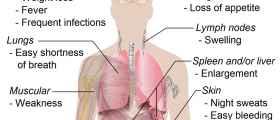
Sarcoidosis is a serious medical condition characterized by formation of collections of abnormal chronic inflammatory cells in multiple organs. These cells form a so called granulomas which are characteristic for the disease. It is estimated that sarcoidosis affects women more than men and it is reported to be more severe in African-Caribbean than in Caucasian people.
Sarcoidosis - Types
Sarcoidosis can be acute and chronic. Acute sarcoidosis (Lofgren's syndrome) develops suddenly and leads to swelling of lymph nodes in the neck or armpits. The skin of lower legs gets covered with tender red lumps or rash and one can additionally develop fever and complain about pain. This form of sarcoidosis withdraws spontaneously. Chronic sarcoidosis is a condition that develops gradually. It is capable of causing severe scarring of the lungs and may be responsible for damage to many organs including the heart and brain. Chronic sarcoidosis is a life-time illness which cannot be cured, but can be controlled by certain drugs.
Sarcoidosis Clinical Characteristics
In certain number of people sarcoidosis is asymptomatic and remains undiagnosed for some time. Still, patients who develop symptoms and signs of the condition may have different complaints which generally depend on the affected organ.
Fever, tiredness, weight loss, chest pain and a feeling of being unwell affect almost all patients. If the lungs are affected, patients experience shortness of breath and cough. The skin of some patients is raised and covered with tender/purple lumps. These skin changes (erythema nodosum) predominantly affect the shins. There is also discoloration of the nose, cheeks, lips and ears. Discoloration additionally affects existing scars. In some areas raised bumps and lumps form under the skin.
Apart from the previously mentioned sarcoidosis may also affect the eyes (blurred vision, glaucoma, cataract etc), bones and joints (ache, swelling etc), heart (chest pain, palpitations, heart failure etc), nervous system (headaches, confusion, paralysis of cranial nerves etc) and other organs such as kidneys, liver and spleen.
Sarcoidosis Treatment
Some patients need no treatment and they are closely monitored so that doctors can have insight in progression or improvement of the condition. On the other hand, if there is need for treatment, it will depend on severity of the symptoms and the affected organs.
Patients may be prescribed pain killers (ibuprofen, paracetamol), steroids and more potent drugs such as immunosuppressors. Steroids are quite efficient, therefore, prescribed to majority of patients. Still, only in case symptoms do not improve in spite of aggressive treatment with steroids, patients are prescribed methotrexate, azathioprine, leflunomide, TNF-blocking agents or hydroxychloroquine.
Since both steroids as well as all the previously mentioned drugs have many side effects, all patients require close monitoring and sometimes adjustment of the dose or even drug replacement.

















Your thoughts on this
Loading...